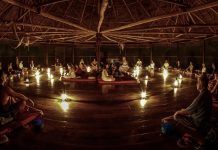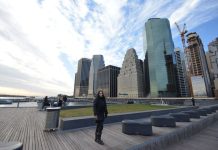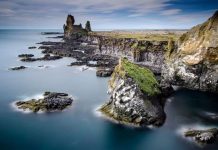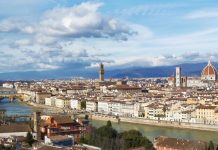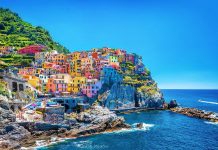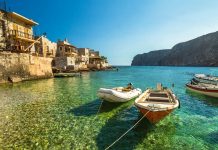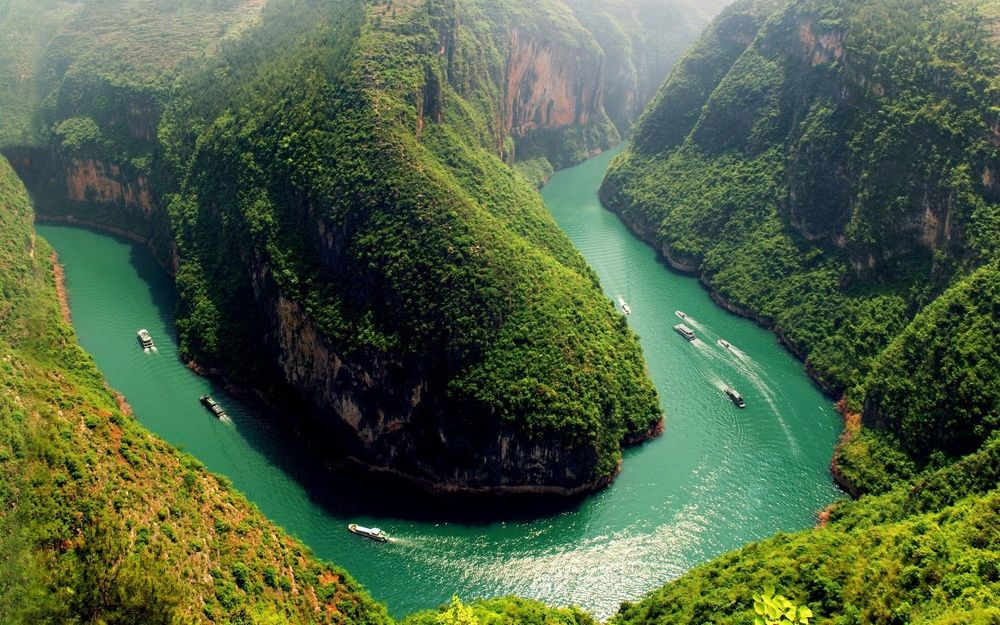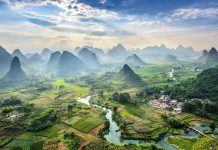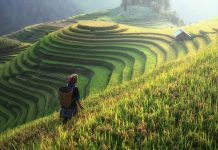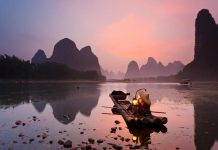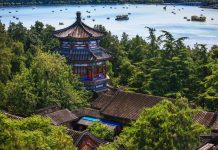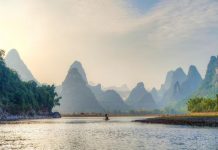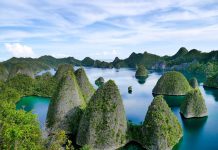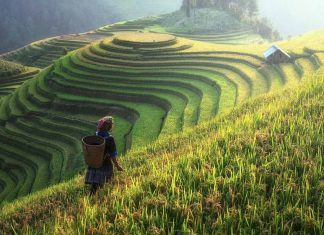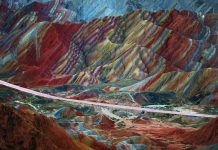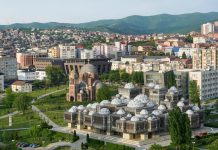The Sutra in stone is the name of a grandiose collection of Buddhist stone sculpture created by the hands of unknown carvers in the grottoes of Longmen. The UNESCO-protected Longmen Cave temples have existed since 494 – since the capital of the kingdom of Northern Wei moved to Luoyang from Datong. For more than 200 years, more than 100 thousand images of the Buddha and his disciples have been carved in limestone rocks along the banks of the Yishui River. The length of the temple complex exceeds a kilometer.
Unfortunately, many statues were beheaded at the beginning of the XX century by ignorant collectors of antiquities. Now the stolen fragments can be seen in the Metropolitan Museum of Art in New York, the Atkinson Museum in Kansas City, the Tokyo National Museum and other reputable collections. At the entrance to the Longmen Caves, a list of lost sculptures is posted indicating the places where they are now located. A small part of the statues were returned to their rightful place, a few more stone heads were carved anew, but most of the damaged statues still show their injuries. The last time Longmen survived the invasion of vandals during the Cultural Revolution of the 1960s.. Finally, the climate also contributed to the destruction of the caves: the faces of many statues were completely washed away by rains over several centuries.
Caves can be seen in the rocks on the western and eastern banks of the river. The most outstanding monuments are located on the west bank, but there is also something to admire on the opposite bank — to do this, you need to cross the river over a bridge. Although Longmen is one of the main attractions of China, there are almost no explanations in English, but all the caves are numbered, mapped and beautifully illuminated at night.
Longmen is located 13 km south of Luoyang. You can get there by taxi or by bus No. 81 – it departs from the east side of the main railway station. The last flight from Longmen to Luoyang No. 81 departs at 20.50. Buses No. 53 and 60 will also take you to the caves.
West Bank
The Three Caves of Binyan
The creation of these grottoes began during the reign of the Northern Wei Dynasty. Although the main works unfolded in the Sui and Tang eras, the style of sculpture is characteristic of Northern Wei. There are traces of paintings in the three main halls and niches hollowed out in the wall of the coastal cliff. In the neighborhood there are Three niches with carved Buddhas decorated with seven statues of the Tang period.
Cave of 10 thousand Buddhas
It is located south of the Bi pya of some caves. The sculptural decoration of this grotto was started by the masters around 680 .. The name of the cave comes from the wall reliefs in which the image of the Buddha is constantly repeated. In addition, in Wangfodong you can see a beautiful statue of Buddha Amitaba. Pay attention to the traces of red paint preserved on the ceiling of the cave.
Lotus Cave
Cave No. 12 was created between 525 and 52 during the reign of the Northern Wei Dynasty. The temple decoration includes a huge statue of a standing Buddha, who has long lost his hands and face. The vaults of the grotto are painted with images of celestial maidens-apsaras hovering around a huge lotus flower – hence the name of the monument. In Buddhism, the lotus is considered a symbol of purity and peace. Pay attention to the cloud-shaped carvings adorning the entrance to the cave.
Ancestor Worship Temple
Despite the wounds inflicted by time, his sculptures are considered the best examples of Buddhist art in Longmen.
The main decoration of Fengxiansa consists of nine sculptures. The sculptures of the Tang era look more realistic and expressive than the creations of the sculptors of the Northern Wei period. Their poses seem more natural. Wei statues are images of inhabitants of another world, while the figures of the Tang period demonstrate the correct proportions and excellent elaboration of the details of the human body. This can be seen by the example of the sculpture of the guardian on the northern wall of the temple.
A sitting Buddha with a height of 1 m depicts Losana. The face of the statue repeats the features of the appearance of the Tsetian — Tang Empress and patroness of Buddhism, whose efforts created Fengxiang. In the corner of the southern wall, next to the image of the guardian, you can see the remains of three badly damaged sculptures.
Cave of Medical Prescriptions
A small grotto to the south of the Fengxiangsi Cave Monastery. Started during the reign of the Northern Wei Dynasty, the cave was completed already under Northern Qi. The name comes from tablets with texts carved in the VI century. at the entrance to the grotto; they set out popular medical advice of the past.
The Original Cave
Next to the cave of Medical Prescriptions, a more spacious grotto, known as the Primordial One, has been cut down. He appeared around 493 . At the back of the narrow hall there is a statue of Buddha, and carved apsaras flutter along the walls.
EAST COAST
After reaching the last cave on the West Bank, cross the bridge and get acquainted with the grottoes east of the Yishui River. Moving in a northerly direction, enter the cave of the Thousand-armed and Thousand-eyed Guanyin at number 2132. A huge relief of the Tang period depicts the goddess of Mercy spreading her many arms on the wall. On each palm is an open eye. Nearby there is a Paradise grotto, also belonging to the Tang era. At the entrance to the high-placed cave of the Gaoping Prince, the figures of the guards, sculpted during the Tang Dynasty, froze. After passing several niches with statues, you will reach the most impressive building on the Eastern Shore – the cave monastery of Sutra Reading.
The ceiling of the monastery is decorated with a lotus image, and statues of arhats are carved at the base of the walls. There is an observation deck near Kanjinsi, which offers a view of the opposite shore and the cave monastery of Fengxiangsi.
The Monastery of the WHITE HORSE
The buildings on the territory of this functioning monastery have been rebuilt several times, but it is considered the oldest Buddhist monument in China at the time of its foundation. According to legend, the envoys of the Khan’s court, sent in search of texts of Buddhist scripture, met two wandering monks from India in Afghanistan. The ambassadors invited the preachers to China, where they arrived, leading two white horses loaded with sacred books and temple utensils. Intrigued, the emperor ordered to build a monastery in Luoyang, named in memory of the white horses that brought the Word of the Buddha to the Chinese.
In the Hall of the Heavenly Kings, a laughing Milafo looks at you from a stunning polished wooden cabinet. Notable buildings of Baimasa include temples of the Great Buddha, Mahavira and Pila. The latter is located in the farthest part of the courtyard. The magnificent 12-tiered Qiyunta Pagoda is located a five-minute walk from the monastery.
GUANYSHNSI Monastery
To the north of the Longmen Caves is the Guanlinsi Monastery, where the legendary commander Guan Yu, who lived in the era of the Three Kingdoms and was deified in China under the name Gu-an-di, is buried. The monastery buildings were built during the Ming dynasty, and the cult of the God of War was finally established already in the Qing era. Buses No. 81 and 55, departing from the main railway station in Luoyang, pass by Guanlinsi: No. 81 makes a stop here on the way back to Luoyang from Longmen. Bus No. 58 runs between Guanyinsi and Baymasy.

